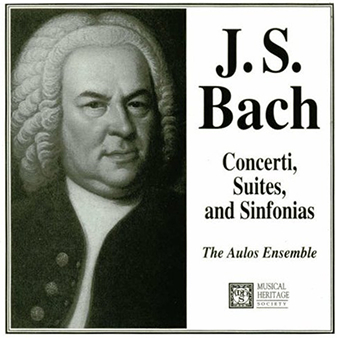 Johann Sebastian Bach (1685-1750)
Johann Sebastian Bach (1685-1750)
Concerto in C Minor for Oboe, Violin, Strings, and Basso Continuo, BWV 1060
Suite in B Minor for Flute, Strings and Basso Continuo, BWV 1067
The Aulos Ensemble
Recorded December 19-20 & 23, 1992 at the Performing Arts Center, SUNY, Purchase, NY (Musical Heritage Society)
ONE-SENTENCE REVIEW:
It doesn’t get any more authentic than this boring ass shit (that’s a joke – lighten up).
ORIGINAL LINER NOTES (by Harris Goldsmith):
“Weimer,” “Cothen” and “Leipzig”: These three locations can be used to neatly divide the towering musical legacy of J.S. Bach – an arrangement analogous to the “Early,” “Middle” and “Late” groupings habitually bestowed upon Beethoven’s output. The tryptych approach for both of these musical geniuses has undeniable utility but can sometimes be misleading.
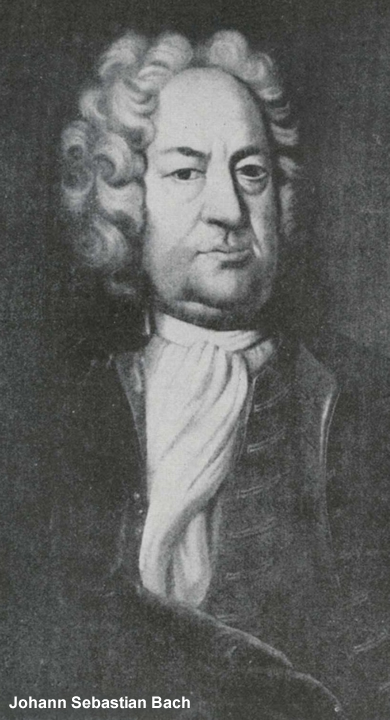 It was in 1713, during his employ as organist to the Duke of Weimar, that Bach first encountered the then new Italian music of Antonio Vivaldi, Tomaso Albinoni, Arcangelo Corelli and the other violinist-composers.
It was in 1713, during his employ as organist to the Duke of Weimar, that Bach first encountered the then new Italian music of Antonio Vivaldi, Tomaso Albinoni, Arcangelo Corelli and the other violinist-composers.
The Duke’s young nephew, Prince Johann Ernst, had developed a passionate fondness for this fare and had brought some of these concerti (recently published in the Netherlands) back with him as additions to his uncle’s library.
Bach had a favorable impression, particularly so in Vivaldi’s case – for he thought sufficiently well of the latter’s music to arrange six of his Concerti Grossi for solo keyboard. And in some of his subsequent original works (the F major Concerto in the Italian Manner, BWV 971, springs immediately to mind), Bach assimilated the style in all its specifics and immeasurably transcended it – an observation that, likewise, applies to several of the compositions heard on this recording.
In 1719, Bach moved to Cothen where he served as Kapellmeister and Director of Chamber Music. The court of Cothen, according to Bach’s biographer Spitta, was “held on a modest scale.” “It had never possessed a theatre and the Reformed (Calvinist) services did not encourage music.” But Bach’s employer, Leopold did. He was, in the composer’s words, “an amiable prince who knew and loved music.”
Indeed, Leopold was an accomplished player of three instruments – the clavier, the violin and the viola da gamba – and it was under his aegis that Bach spent what was reputably the happiest part of his life and certainly – at least in terms of purely instrument music – the most productive. During this period, he penned the six suites for unaccompanied cello, the sonatas and partitas for violin, the concertos for violin (all but three of which are lost), all six Brandenburgs and Book One of the Well Tempered Clavier – all in all, a pretty fair accomplishment.
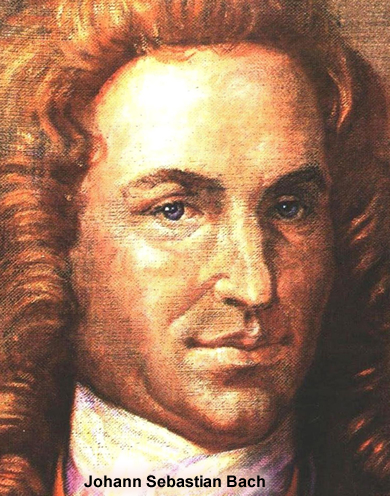 All good things must come to an end and, unfortunately, the good prince too him self a spouse who didn’t share his affection for music and, moreover, resented her noble husband’s consorting with one of his servants (by then, a close friendship had developed between Bach, who was already a musical celebrity, and the much younger prince). In fact, the good (?) woman was instrumental in hastening Bach’s departure to St. Thomas and it was in Leipzig where he stayed to his dying day.
All good things must come to an end and, unfortunately, the good prince too him self a spouse who didn’t share his affection for music and, moreover, resented her noble husband’s consorting with one of his servants (by then, a close friendship had developed between Bach, who was already a musical celebrity, and the much younger prince). In fact, the good (?) woman was instrumental in hastening Bach’s departure to St. Thomas and it was in Leipzig where he stayed to his dying day.
Bach began his tenure as Cantor at St. Thomas in 1723. He was the third choice for the position, hired only after Georg Philipp Telemann (1681-1767) and Christoph Graupner (1683-1760) had declined the offer. His duties were primarily ecclesiastical and although he had, until then, composed relatively little church music, he was now required to produce cantatas every Sunday, and for major church holidays as well.
By 1729, he had composed four complete cycles, each numbering about sixty cantatas, and he had composed two Passions in addition. But he felt disillusioned because there was little support or enthusiasm for his efforts.
This lack of gratitude led to his seeking an additional outlet and incentive for his creativity and he thus became director of the Collegium Musicum, an organization of university students that had been established by Telemann in 1702, when he was studying law in Leipzig. Meeting at Zimmermann’s coffee house – and, during the summer months, outdoors – this amiable assemblage performed a wide variety of secular vocal and instrumental music.
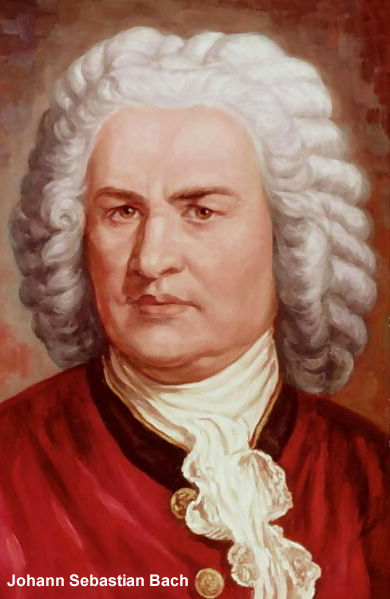 With so much music to compose, it is little wonder that Bach was not above occasionally recycling an earlier work or two for reuse. For his Cantata No. 156, for instance, he devised its Sinfonia by transposing the slow movement of his Cothen period Harpsichord Concerto in F Minor, BWV 1056 downward from A flat Major to F Major. Or, more correctly, this lovely movement for oboe solo is a borrowed item from a lost concerto for either violin or oboe (of which the Harpsichord version is a subsequent arrangement).
With so much music to compose, it is little wonder that Bach was not above occasionally recycling an earlier work or two for reuse. For his Cantata No. 156, for instance, he devised its Sinfonia by transposing the slow movement of his Cothen period Harpsichord Concerto in F Minor, BWV 1056 downward from A flat Major to F Major. Or, more correctly, this lovely movement for oboe solo is a borrowed item from a lost concerto for either violin or oboe (of which the Harpsichord version is a subsequent arrangement).
Similarly, the Concerto for Oboe and Violin, BWV 1060 is a bit of speculative guesswork: a reconstruction of a Cothen period concerto, either for two violins or (more probably) for oboe and violin, that was among the aforementioned lost works from that epoch.
Again, the concerto’s musical material survives by way of the composer’s later arrangement for two harpsichords. To my ears, it sounds far more agreeable in its presumed original instrumentation, and the aural superiority is particularly striking when one compares the central Adagio – angular and earth-bound in its dual-keyboard form, but flowing “on wings of song” when intoned by oboe and violin. In its three movement, fast-slow-fast format, and its subtle alternation of solo instruments alongside (but sometimes in juxtaposition with) the tutti strings and continuo, BWV 1060 – in whichever form – is recognizably “to the Italian taste.”
So, too, is the Fifth – and arguably grandest – of the immortal Brandenburg Concertos. Dating from circa 1719 (it is all but impossible to ascertain definite vintage dates for most of Bach’s output), the concerto was probably composed to inaugurate the new harpsichord that Bach had brought back from Berlin. Probably the last of the six, the Fifth Brandenburg, like its brethren, shows how Bach had assimilated all the stylistic prerequisites of Italian style but, with his genius for innovation, far transcended the “role model” in terms of structural dimensions and spiritual profundity.
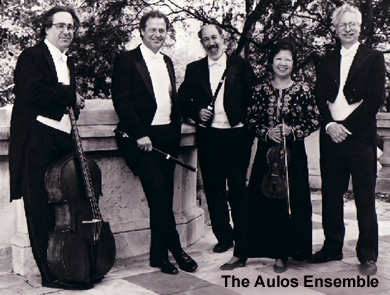 On a purely subjective plane, confluence of the solo concerto and the concerto grosso – with its gigantic written-out first movement cadenza – the work is unmistakably a harpsichord concerto, and one that paved the way to, if not Liszt and Rachmaninoff, certainly to Beethoven.
On a purely subjective plane, confluence of the solo concerto and the concerto grosso – with its gigantic written-out first movement cadenza – the work is unmistakably a harpsichord concerto, and one that paved the way to, if not Liszt and Rachmaninoff, certainly to Beethoven.
Conversely, and heart-stoppingly so in its central unaccompanied Affetuoso, the spirit of intimate chamber music – a memorable three-way conversation between the harpsichord (now subdued where it was, just a movement earlier, explosively public), violin and flute. Incidentally, this is the first time Bach wrote specifically for the flauto traverso, or transverse flute, rather than (as in the Fourth Brandenburg) for a pair of recorders. In the final Allegro, Bach repeatedly uses a sprinting figure indicated in conventional baroque notation wherein the upbeat is written as a sixteenth note rather than as the third of a triplet (which is almost certainly the way it was intended to sound).
Bach’s four orchestral suites (sometimes called Ouvertures) are in the French rather than the Italian style. Two of them (No. 1 in C, BWV 1066, and No. 4 in D, BWV 1069) were composed at Cothen, the others (No. 3 in D, BWV 1068 and the present No. 3 in B Minor, BWV 1067) at Leipzig.
The B minor Suite, despite its misleading designation as “No. 2,” was the last, with a vintage date from the 1730s. Unlike the clarion trumpet and tympani-laden D major works and the relatively more subdued but still strongly oboe-permeated C major, the B minor Suite projects a grave persona, sternly-but tenderly set forth by a solo flute against a backdrop of strings and continuo. Its eponymous Ouverture fulfills its role as a throat-clearing call to order without violating the work’s essential intimacy. It somewhat reminds this listener of the opening Sinfonia of the C minor Partita for keyboard, BWV 826 (but unlike that work, returns to the slower-moving opening material).
A series of contrasted dances follows: First a Rondeau, then a Sarabanda, a pair of Bourrees, a Polonaise and its double variant, a Menuet and, finally, a Badinerie – Bach’s only know use of this bantering plaisanterie (“Badinerie” or “Badinage” can be translated to mean jest, trifle or piece of fun).
TRACK LISTING:
- 1-3: Concerto in C Minor for Oboe, Violin, Strings and Basso Continuo, BWV 1060
- 4-6: Brandenburg Concerto No. 5 for Flute, Violin, Obbligato Harpsichord, Strings and Basso Continuo, BWV 1050
- 7: Sinfonia in F Major “Ich steh’ mit einem Fulz im Grabe” for Oboe, Strings, and Basso Continuo, BWV 156
- 8-14: Suite in B Minor for Flute, Strings, and Basso Continuo, BWV 1067
FINAL THOUGHT:
And “piece of fun” it is because once you go Bach you never go back! (Hey, what do you want from me?! I’ve been listening to nothing but Bach for the past week!)
 Emily Sachs – President – Manka Music Group (A division of Manka Bros. Studios – The World’s Largest Media Company)
Emily Sachs – President – Manka Music Group (A division of Manka Bros. Studios – The World’s Largest Media Company)


